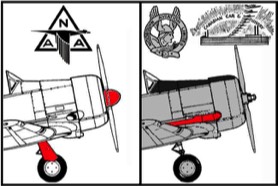Frequently Asked Questions about the T6 Harvard
Q – Why do some Harvard’s have Gear doors and some don’t?
 A – All NAA-built Harvard Mk IIs had gear doors fitted from the factory. However, when they got to Canada, they were probably the first things to be removed! In winter operations snow and ice would accumulate between the door and the landing gear and would sometimes freeze the gear in the up position. This is why you don’t see doors fitted to Noorduyn and CC&F built Harvards. (I guess I should say ‘most’ Noordyun-built Harvard’s. The earliest ones did have them fitted, but later ones did not.) The landing gear casting on the Mk 4 for example doesn’t even have the attachment fitting for the gear doors. Harvard’s and Texans that served in warmer climates usually kept them fitted.
A – All NAA-built Harvard Mk IIs had gear doors fitted from the factory. However, when they got to Canada, they were probably the first things to be removed! In winter operations snow and ice would accumulate between the door and the landing gear and would sometimes freeze the gear in the up position. This is why you don’t see doors fitted to Noorduyn and CC&F built Harvards. (I guess I should say ‘most’ Noordyun-built Harvard’s. The earliest ones did have them fitted, but later ones did not.) The landing gear casting on the Mk 4 for example doesn’t even have the attachment fitting for the gear doors. Harvard’s and Texans that served in warmer climates usually kept them fitted.
Shane Clayton
Nowadays a lot of Canadian-built machines added the undercarriage doors and propeller spinners. Actually some others went as far as removing the wheel covers, probably to give a “GT” look. Perhaps they are not aware that by doing this the uncovered wheels generate turbulence enough in the belly of the aircraft to reduce the speed almost 10 MPH: The covers are there for a good reason!
Joao M Vidal ex PoAF
Q – How much does it cost to run a Harvard – (The below is in US $ – I will prepare a UK £ comparison at some point)
A – The first hour is about $150,000…my annual expenses were about $4000.00 yr insurance, $4800.00 yr hangar, $18,000 for100 hours of fuel @ 30 gph average, $5,000-10,000 for annual maintenance….so…some variables will be engine and prop rebuilding time ($70,000 plus including remove and install, shipping, new fuel and oil hoses)… real cost per hour ?…$400-600 with engine reserve etc…Plus pilot wages and training which needs vectoring in, business marketing ($40 – $80,000 per year) accountants and bookkeepers and a plethora of other smaller costs Mark Hutchins
To really break even in the UK you need to estimate at least £600 plus VAT very expensive but considerably cheaper than a Spitfire or Hurricane!
Q – Why are the propeller tips on the Harvard supersonic?
A – 2250 rpm is the speed of both the prop and engine. It’s a direct drive unless it has a geared engine (R-1340G) like on the DHC-3 Otter. So with no reduction gear and a direct drive, the propeller enters the transonic range making the distinct rasping noise of the T6 Harvard. Some say that it has the direct drive purely as it was the cheaper option at the time for a training aircraft
Q – What does SNJ stand for?
A – The U.S. Army Air Corps’ designation AT-6, stood for Advanced Trainer, sixth design. The U.S. Navy’s basic designation of the same aircraft was SNJ, which meant Scout-Trainer built by North American.
Q – When did Harvards get the long exhaust?
The long exhaust came out on the NA-66 (first Mk II’s) and was used on the NA-75’s, NA-76’s (including AJ841) NA-81’s and all the Noorduyn-built Mk IIB’s and AT-16’s. It continued on to the postwar Mk 4. Same part numbers – (Shane Clayton)
Q – Why is there a Penny in the front of the R1340 radial engine?
Allied Aircraft Pistons of WWII,” White speculated that the tradition had nothing at all to do with Pratt & Whitney manufacturing practices and most probably began following WWII when engines were overhauled in the transition from military to civilian use.
“I’ve had engines come up to my shop from Pensacola [FL], preserved you might say, untouched since they were made, with pennies on the engine dated in the 1930s,” says Mangel. I was back to including pennies on Wasps and Hornets prior to WWII for all kinds of planes including Lockheed Vegas, and Chance Vought-built Navy observation aircraft. Wiley Post’s Vega used the same P&W around the world twice between 1931-1933.